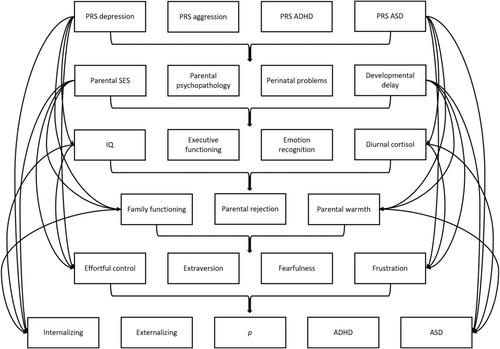The general factor of psychopathology, often denoted as p, captures the common variance among a broad range of psychiatric symptoms. Specific factors are co-modeled based on subsets of closely related symptoms. This paper investigated the extent to which wide-ranging genetic, personal, and environmental etiologically relevant variables are associated with p and specific psychopathology factors.
Using data from four waves (ages 11–19) of TRAILS, we modeled a bifactor model of p and four specific factors [internalizing, externalizing, ADHD, Autism Spectrum Disorder (ASD)]. Next, we examined the associations of 19 etiologically relevant variables with these psychology factors using path models that organized the variables according to the distal-to-proximal risk principle.
Collectively, the etiologically relevant factors, including temperament traits, accounted for 55% of p's variance, 46% in ADHD, 35% in externalizing, 19% in internalizing, and 7% in ASD. The low 7% is due to insufficient unique variance in ASD indicators that load more strongly on p. Excluding temperament, variables accounted for 29% variance in p, 9% ADHD, 14% EXT, 7% INT, and 4% ASD. Most etiologically relevant factors were generic, predicting p. In addition, we identified effects on specific factors in addition to effects on p (e.g., parental SES, executive functioning); only effects on specific factors (e.g., parental rejection); opposite effects on different factors [e.g., diurnal cortisol (high INT but low EXT, p); developmental delay (high ASD and p but low EXT)]. Frustration, family functioning, parental psychopathology, executive functioning, and fearfulness had strong effects on p.
(1) Strong generic effects on p suggest that etiologically relevant factors and psychopathology tend to cluster in persons. (2) While many factors predict p, additional as well as opposite effects on specific factors indicate the relevance of specific psychopathology factors in understanding mental disorder. (3) High frustration, neurodevelopmental problems, and a disadvantaged family environment primarily characterize p.


